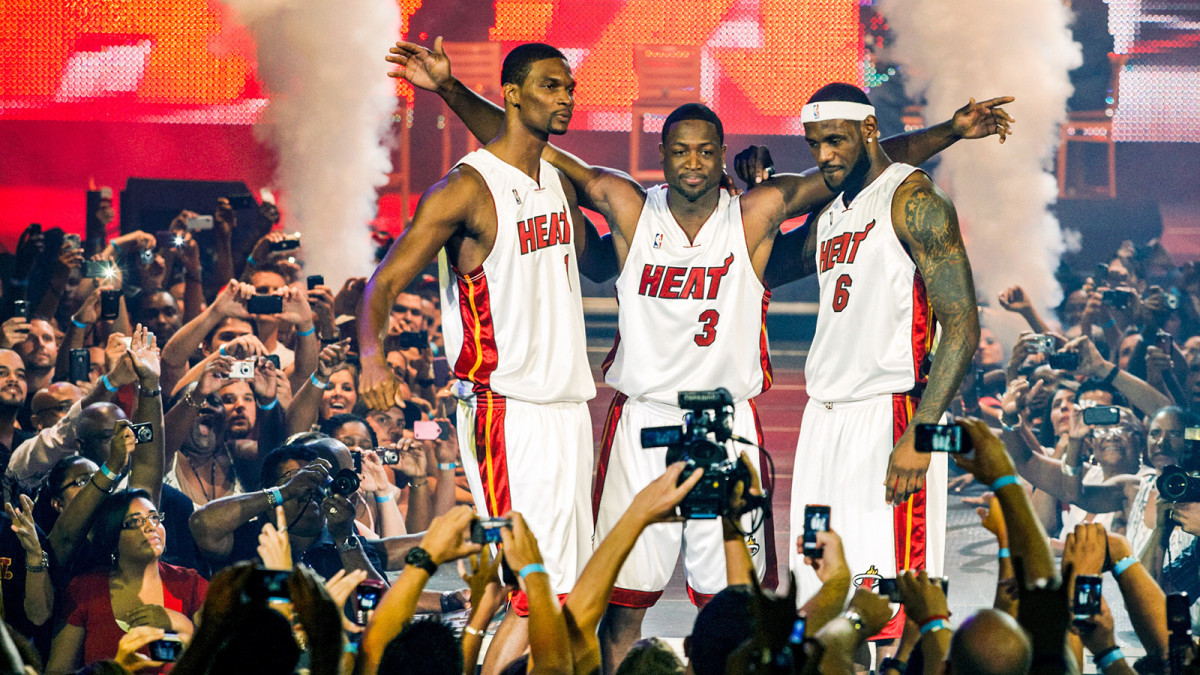How Should the Heat’s Big Three Be Remembered?
“I’m not presumptuous enough to think you should always win. But you had that team. We were that team.”
That’s what Erik Spoelstra, wistfully overlooking Biscayne Bay, told then-SI senior writer Lee Jenkins in 2014 after the end of the Big Three era in Miami. For the previous four years, South Florida had been the center of the basketball universe. From the moment LeBron James decided to join the Heat on July 8, 2010, he, Dwyane Wade, and Chris Bosh formed one of the most thrilling, polarizing, exhausting, and gripping trios in all of sports.
The Big Three, as they came to be known, was a captivating basketball experiment, one that produced literal (the dunks!) and figurative (27-game win streak!) highs on the court and spurred incredible hot takes off of it (the Dan Gilbert letter!) before eventually crashing back down to earth in a warm San Antonio gym.
The Decision, LeBron James’s televised special announcing his intent to sign with the Heat, was the flashpoint moment that set the stage for one of the most intensely scrutinized teams in the athletic history of this country. Ten years from the moment James said he would be taking his talents to South Beach, what is the legacy of the Miami superteam?
On the court, calling the Heat a disappointment may be too much, but the team certainly left a little to be desired. Making four straight Finals is absolutely nothing to scoff at. But the expectations—set by James himself when he infamously rattled off how many rings he thought he, Wade, and Bosh were capable of at the greatest welcome rally of all time—were much higher than two rings, a sentiment Spoelstra himself shared with Jenkins in 2014.

In terms of the greatest teams ever, while Miami at its best was perhaps as good as any of them, the Heat really needed a third ring to be in the category of the all-time greats. The Heatles are probably closer to the Bad Boy Pistons in terms of legacy than some of the league’s more indelible outfits. A third championship would have put Miami in the conversation with Shaq and Kobe’s Lakers, or even the late-2010s Warriors. Instead, the Heat fall just short, thanks in large part to their collective collapse in the 2011 Finals, which saw a heavily favored Miami team—up 2–1 in the series—lose to a veteran-but-not-star laden Mavericks squad, providing catharsis for a country eagerly rooting for the underdog.
As much as that loss may have chipped away at the Heat’s legacy, it also propelled them for success moving forward.
“You never want to say it, but losing to Dallas was the best thing to happen to us,” Wade told SI during his final season in 2019. “Because if we won . . . oh, man. I don’t know what we would have done. We would have been so out of our minds . . . it would have been like a middle finger up to everybody.”
James, in an email to SI in 2019, echoed his running mate’s thoughts: “We had gotten away from playing with passion and pure love of the game, so it humbled us and refocused us. It got us back to saying, ‘Let’s just have fun, let’s play for one another, let’s understand why we came together.’ [Dwyane is] right. It was a big motivation as to why we were able to be successful after that.”
After the Mavs loss, the motivated Heat reeled off two straight rings, with plenty of unforgettable moments along the way. “It’s about damn time.” LeBron’s Game 6 in Boston. Ray Allen’s Shot. LeBron’s “MJ Moment.” The end was far less exciting, as an old, hobbled, and mentally drained Heat team was run off the floor by the Spurs in the 2014 Finals, perhaps giving James the final push to head home to Cleveland.
By the summer of 2014, everyone seemed pretty miserable.
“Every situation we were in we were fighting to just stay above board, trying to figure out how to sleep or rest our bodies,” Ray Allen told SI in 2017. “We wore down, we were tired, and we were definitely tired at the end.”
Last year, Wade told SI he was considering retirement around the end because of the trouble his knees were causing him. Spoelstra told SI earlier this season he had become so obsessed with the final result during the LeBron years that he would eventually feel he had to apologize to some of his players for not being the coach they needed him to be. As much a physical toll four straight Finals trips put on the players’ bodies, the spotlight of being that team seemed to wear them down as much as anything else.
While the on-court results never reached the heights imagined by the Big Three themselves when the team was formed, that vulnerability was a huge part of what made the Heat so captivating. Miami’s flaws ultimately contribute to how memorable that team was. The Heat weren’t a juggernaut. They inspired hatred. And their backs were against the wall enough times that the fragility of the experiment was always evident. The Big Three had a flair for the dramatic, and the fact that losing was often a very real possibility in some ways made them more interesting than say, the Kevin Durant-led Warriors of recent history.
The off-court impact also can’t be understated. LeBron’s decision was the first domino to fall in the player movement era. The subsequent machinations of guys like Durant, Kawhi Leonard, Paul George, Kyrie Irving, Anthony Davis, and others can all be traced back to James’s signing in Miami.
“We knew that we were changing the landscape of the NBA,” Wade told SI last year. “Everybody knows that year kind of changed the mentality of players a little bit. That’s something we are proud of, we are proud of putting the power in the players’ hands.”
Media has also changed as a result of the Big Three. The hatred and spotlight of the first season in particular eventually gave way to an awakening of sorts, with player decisions (for the most part) spurring much less pure vitriol as it did in 2010. By 2014, James was hailed as a hero for signing with the Cavaliers, announcing his second decision via letter in an esteemed publication, though there were definitely some basketball motivations for his move as well.
The legacy then, of the Big Three, much like their actual basketball journey, is not neat. At its height, the team could compete with any of history’s best, but its peak was too short to be considered in the pantheon of all-time squads. Part of the Heat’s appeal was the fact that they weren’t perfect, and their vulnerabilities added dramatic heft to the gripping highs and lows. History won’t remember the Big Three as the greatest team of all time. But it will remember them as one of the most captivating, most exciting, most infuriating, and most interesting teams ever, and one that had an effect in the NBA ecosystem long after its disbanding.
After all, as evidenced by the since-widely derided welcome party one day after The Decision, the Big Three didn’t even need to be playing to have everyone’s attention.
“Looking back on it now, if someone said that wasn’t awesome, I’d be like, ‘Come on, bro. Stop. You don’t think that was cool?,’” Bosh told SI about the welcome rally in 2019. “That hasn’t even happened again. Nobody ever did that.
”30,000 people in the seats and we didn’t even have a basketball.”
